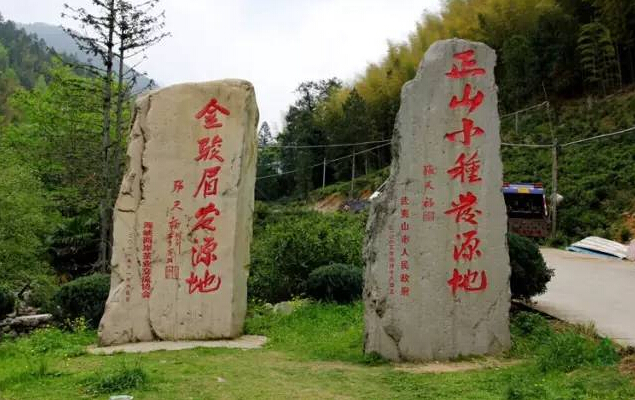The birthplace of Jin Jun Mei—Tongmu Village in Wuyishan City—is the source of the Min River and the Nine-Bend Stream, as well as a national nature reserve. Tongmu Village has been praised by biologists as a "green emerald," "kingdom of snakes," and "paradise of birds." The high humidity and constant mist make it an ideal environment for tea tree growth.

Over 400 years ago, this was the origin of world black tea, giving birth to the ancestor of black tea—Lapsang Souchong. Four centuries later, another new black tea variety emerged here—Jin Jun Mei, whose popularity is astonishing, rising from creation to fame as a miracle.
So, how was Jin Jun Mei born?
In June 2005, two tea enthusiasts from Beijing, Mr. Zhang and Mr. Yan, arrived at Tongmu Village in Wuyishan. Liang Junde, a master tea maker with decades of experience in Lapsang Souchong, was approached by the two guests with a request to use tea buds to create a premium black tea. They selected buds from small-leaf tea trees, harvesting over two pounds of fresh leaves. Liang Junde recalled, "We had never used top-grade buds to make black tea before, so we had to experiment while processing."
Due to limited conditions, they couldn’t sun-wither the leaves or use specialized withering equipment. Instead, they placed the buds on a sieve under a "small sun" lamp, turning them occasionally. Given the tenderness of the buds, after withering, they were placed on glass panels for rolling. During the final step, an idea struck: since the buds were so precious, the process should differ from traditional Lapsang Souchong methods, which involve drying over pinewood smoke, imparting a light smoky flavor. What if they tried an innovative approach to create a non-smoky version?
They used an oven for drying, producing less than half a pound of tea. The tea had a tight, slender appearance with a mix of gold, brown, silver, and black, a golden liquor, and a sweet floral and honey aroma. The smooth, sweet aftertaste left everyone present in awe. On June 22, 2005, the first batch of Jin Jun Mei was born.
As described, Jin Jun Mei introduced two key innovations compared to traditional Lapsang Souchong:
First, it used top-grade buds, departing from the conventional use of one bud and two or three leaves.
Second, it employed oven drying instead of pinewood smoking, resulting in a distinct honey aroma." Mr. Yan noted that the dried tea resembled human eyebrows in shape, and since it was crafted by Master Liang Junde, they incorporated the character "Jun" (骏) into the name, hence "Jun Mei."
The following year, the two Beijing tea lovers returned and asked if one bud and one leaf could be used. Liang Junde replied that if whole buds worked, one bud and one leaf would be even easier, as the leaves aided withering. This led to the classification of "Jin Jun Mei," "Yin Jun Mei," and "Tong Jun Mei" based on quality.
1. Dry Tea Appearance
(1) Authentic Jin Jun Mei buds are medium-sized, mostly black with some gold, not overly shiny. The strands are tightly curled, slender, and highly twisted.
(2) Non-authentic Jin Jun Mei can be categorized as follows:
A. Coarse strands with a floral scent but poor endurance, similar in color to authentic tea, often made from the "Mei Zhan" variety, which doesn’t grow in Tongmu Village.
B. Extremely fine strands, typically from clonal small-leaf tea bushes propagated by cuttings, resulting in uniform, monotonous quality.
C. Predominantly golden with excessive fuzz, usually non-authentic.
D. Similar gold-black ratio to authentic tea, but the colors are distinctly separate on the strands, indicating blending.
2. Tea Liquor Color
(1) Authentic Jin Jun Mei can be brewed with 100°C water, producing an amber, clear liquor.
(2) Non-authentic versions tend to be reddish and cloudy.
3. Brewed Leaf Shape
(1) Authentic Jin Jun Mei has strict picking standards, with few or no open leaves. Each bud stands upright, resembling eyebrows.
(2) Non-authentic versions have more open leaves, a soft texture, and turn mushy after multiple brews.
4. Brewed Leaf Color
(1) Authentic Jin Jun Mei leaves are a vibrant bronze.
(2) Non-authentic versions are either bright red (due to closed fermentation) or dull black.
5. Taste and Aroma
(1) Authentic Jin Jun Mei offers a sweet, honeyed flavor with a lingering aftertaste, smooth and rich, enduring over eight brews.
(2) Non-authentic versions often have a roasted, sweet-potato-like aroma, astringency, and poor endurance.
Amid its soaring popularity, Jin Jun Mei faces market chaos. Ensuring its premium status and longevity in the ever-changing tea market remains a challenge.
Ultimately, tea appreciation is personal—whether for taste or spiritual pursuit. The tea world may be chaotic, but our mindset shouldn’t be. Whether tea brings peace depends on our attitude toward it, not the other way around. Remember, tea liquor isn’t "chicken soup."